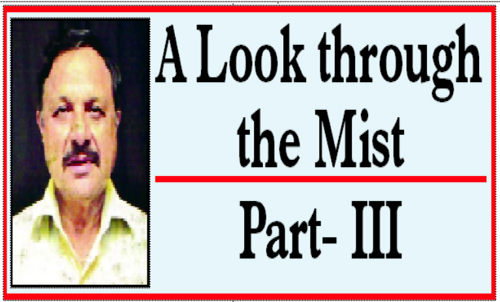Will Rahul Gandhi work for undoing amendments made to Art 74 of COI by 42nd & 44rth Amendment Acts
-
With present form of Art 74 President cannot freely work as Preserver, Protector & Defender of COI
-
With the riders put in Art 74 by 42nd & 44rth Amendment Acts of 1976 & 1979 President is not free to go by oath taken under Art 60
-
If it was Indira Gandhi during Emergency responsible for Amending Art 74 in 1976 it was Janta Govt in 1979

DAYA SAGAR
A very typical and unique feature of the constitution of India that was drafted & adopted by the Constituent Assembly of India on 26 November 1949 has been that though The President of India for general legislative purposes / governance appeared like a nominal head of ‘State’ but he/she is in a way given the very special responsibility under oath to Protect & Defend the Constitution of India { Art-60 of COI }.Not only that although like US President the Vice President of India can hold the office of the President during his/ her absence but for India the vacancy if there, has to be filled by a fresh election with in prescribed time ( 6 months).
Not only that ,the President of India has also been well protected against any otherwise intentions of “those” elected by the citizens of India for a particular term ( five Yrs) who may not venture to assume to their self ultimate authority once elected and even overstep their delegations / confidence imposed in them by voter citizen which could be well read from the provisions as made as regards impeachment of President (Art-61: Procedure for impeachment of the President ).
Notwithstanding review jurisdictions, those who drafted The Constitution of India ( COI) in 1949 through the Constituent Assembly surely wanted the Constitution to be an adaptable citizen friendly democratic socialist document but they were at the same time very much conscious of their limitations, circumstances in hand , having no any previous experience of having lived in such like system of governance and had no experience of the type so they did not want to give their generations a rigid/ closed framework for governance so they had also kept a provision in Art 368 for amendments by Parliament using power like constituent power but not beyond the basic principles enshrined in the document at the time of adopting it in 1949..
So far the Indian Constitution has been amended 105 times by Parliament of India using constituent power resting in Art – 368 . Some of the amendments have been made in the existing provisions to explicitly project the spirits/principles enshrined in the ‘hearts’ of constitution like the insertions made in the text of the Preamble { using/substituting “Sovereign Socialist Secular Democratic Republic” by Forty-second Amendment Act, 1976, s.2, for “Sovereign Democratic Republic” (w.e.f. 3-1-1977). And using expression/ substituting “unity and integrity of the Nation ” by s.2, ibid., for “Unity of the Nation” (w.e.f. 3-1-1977) by making insertions } and some of the amendments have been made keeping in view implementation of welfare intentions laid down in some articles of the constitution/ directive principles / fundamental rights / like as through The Constitution (First Amendment) Act, 1951 June 18 1951 where under Art 15,Art 19, Art 31, Articles 85, 87, 174, 176,341, 342, 372 ,376 were amended and Ninth Schedule was added after 8th Schedule and (The Constitution (Fourth Amendment) Act, 1955 17 April 1954 where under articles 31, 31A & 305 of, and the Ninth Schedule to the Constitution were amended.
The substitutions made in the text of Preamble of Constitution of India have been very much within the powers of Parliament as laid in Art 368 of COI since the concerned section of the 42nd amendment Act of 1976 have been very much within the doctrine of basic structure of COI as professed in The 13 Judge – Bench Judgment of Supreme Court of India delivered on 24 April 1973 in Kesavananda Bharati Vs State of Kerala (His Holiness Kesavananda Bharati Sripadagalavaru etc. v. State of Kerala and another etc. had held that Parliament has powers to amend the Constitution using Art- 368 but the Parliament cannot go beyond disturbing the basic structure of the Constitution of India and all amendments made to constitution are subject to judicial review).
Article 368 of the Constitution may give to some the impression that Parliament’s amending powers are absolute and encompass all parts of the document but the position is not like that . The Supreme Court can go for checks through reviews. and It has been only in that context, with the intention of preserving the original ideals of the visionary constitution-makers enshrined there in, that the Supreme Court of India laid down in 1973 ( Judgment of 13 judge Constitution Bench in Kesavananda Bharati Sripadagalavaru etc. v. State of Kerala and another etc. delivered on 24 April 1973 ) that Article 368 cannot be used by Parliament to amend the constitution so as to distort, damage or alter the basic features of the Constitution under the pretext of amending it. Although the phrase ‘basic structure’ itself” is not found in the Constitution but the Supreme Court had placed before the citizens this concept in black & white for the first time in Kesavananda Bharati case in 1973 as somehing like commonly understood as Doctrine of Basic Structure . But supreme court has in a way reserved the jurisdiction to ‘self’ to name the elements of basic structure of COI as and when case for review comes before the apex court.
To be continued
(The writer is Sr Journalist, social activist and analyst J&K affairs).
